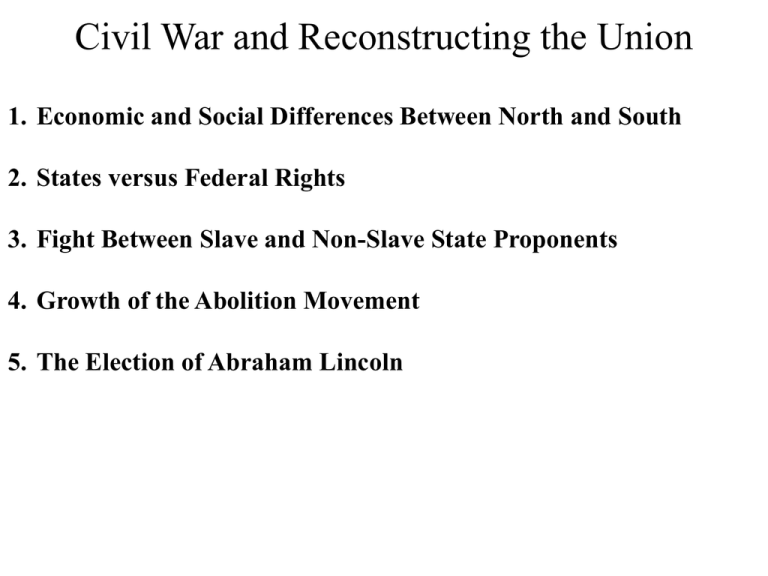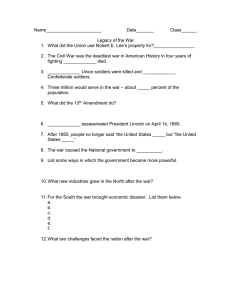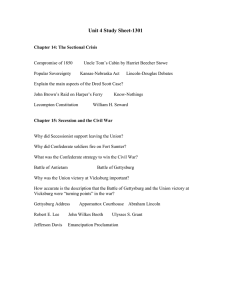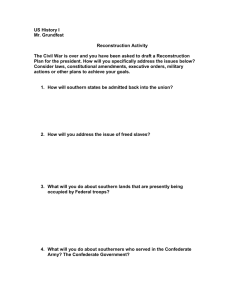Fall 2015 Civil War and Reconstructing the Union(4).ppt
advertisement

Civil War and Reconstructing the Union 1. Economic and Social Differences Between North and South 2. States versus Federal Rights 3. Fight Between Slave and Non-Slave State Proponents 4. Growth of the Abolition Movement 5. The Election of Abraham Lincoln Civil War Overview Defining the Civil War • “War of Northern Aggression,” “War between the states” •Sprit apart the nation •Historical memory of South •Lincoln: “New birth of freedom” •Union Army General Carl Schurz: “A revolution half-finished” Geographical Locations: 10,000 places Death: over 600,000 died Ironies: •Robert E. Lee: turned down offer to command Union forces •Lincoln: Four brother-in-laws fought for Confederacy •Winchester, Virginia: changed 72 times •Missouri: 39 regiments to fight in siege of Vicksburg Diversity of Participants in Civil War Native Americans • Union and Confederate military • 28, 693 served: Pea Ridge, Second Manassas, Antietam, Cold Harbor • Cherokee: minority supported Confederacy/ majority Union • Creek and Cherokee: slaveholders/ political-economic alliance Hispanics • 20,000 +• Variety of motives • Confederacy: southeast and Gulf Coast region • Creoles: French, Spanish, Caribbean • Union: Philadelphia, New York, Boston • Goal of becoming American • Garibaldi Guard: named after Italian freedom fighter Water and the Civil War Impact of Water on Soldiers • Dirty Water • Deaths • Fixed grid pattern camps: Southern mud camps Water and War • Swamps and salty tidal marches/Florida and North Carolina • Remote bayous in MS • Mosquitos and New Orleans • Battles: • Conditions • Barefoot Confederate soldiers: Manassas (August 1862) Selected Biographies Abraham Lincoln •Republican lawyer from backwoods •Revered speeches: 1863 Gettysburg & 2nd Inaugural Address (1865) Luis F. Emilio •16 year old son of Spanish immigrant/ lied about age/ enlisted Union •54th Massachusetts Regiment- one of first African American units Clara Barton •“Angel of the Battlefield” •Union Nurse: Battle of Bull Run Nathan Bedford Forest •Uneducated farm-boy. Lt. General Confederate. •Fort Pillow Massacre, 1865, Mississippi River, Tennessee, Black Soldiers •KKK- 1866, former Confederate soldiers Walt Whitman •“Leaves of Grass,” wounded brother in Vicksburg •Visited wounded in Union field hospitals John Wilkes Booth •Actor, Southern sympathizer, Spy •Assassinated Lincoln, Ford’s Theatre, 1865, Lee surrender, Appomattox Reconstruction, 1863-1877 Emancipation Proclamation, 1863 • Surge in Union black participants • Cultural meanings Reconstruction- began during the War • 1864: Repeal of Fugitive Slave Laws • 13th Amendment • Bureau of Refugees, Freedmen, and Abandoned Lands • Sharecropping: cycle of impoverishment • Civil Rights Bills, 1866 • Reconstruction Acts • 5 military regions in South, National Archives, state constitutions • 14th Amendment: citizenship • 15th Amendment: right to vote • Civil Rights Act 1871- KKK Act • End of Reconstruction: • Election of 1876 • Compromise of 1877/ Democratic control of South Southern Response • Black Codes • 1868-1871- establishment of terrorist organizations- Ku Klux Klan • The Lost Cause Movement The Jim Crow Era: 1877 to (1954) to… Origins of Jim Crow •“Jumpin’ Jim Crow” •Thomas Dartmouth- New York • Minstrel shows: Blackface, Racist portrayal of Blacks • Popular: 1850 and 1870 The Period of Jim Crow •Disenfranchisement, Segregation, Violence •Jim Crow Laws • Prohibited interracial marriages • Segregated schools and public facilities • North Carolina: Prohibited white students from using textbooks shared by Black youth • Voting: “grandfather clause,” literacy tests, poll-tax •Lynching • 1868-1876- 50-100 lynchings per year (recorded) • Tuskegee Institute: 3,446 blacks and 1,297 whites (1882-1968)





